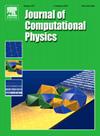Undisturbed velocity recovery with transient and weak inertia effects in volume-filtered simulations of particle-laden flows
IF 3.8
2区 物理与天体物理
Q2 COMPUTER SCIENCE, INTERDISCIPLINARY APPLICATIONS
引用次数: 0
Abstract
In volume-filtered Euler-Lagrange simulations of particle-laden flows, the fluid forces acting on a particle are estimated using reduced models, which rely on the knowledge of the local undisturbed flow for that particle. Since the two-way coupling between the particle and the fluid creates a local flow perturbation, the filtered fluid velocity interpolated to the particle location must be corrected prior to estimating the fluid forces, so as to subtract the contribution of this perturbation and recover the local undisturbed flow with good accuracy. In this manuscript, we present a new model for estimating a particle's self-induced flow disturbance that accounts for its transient development and for inertial effects related to finite particle Reynolds numbers. The model also does not require the direction of the momentum feedback to align with the direction of the particle's relative velocity, allowing force contributions other than the steady drag force to be considered. It is based upon the linearization of the volume-filtered equations governing the particle's self-induced flow disturbance, such that their solution can be expressed as a linear combination of regularized transient Stokeslet contributions. Tested on a range of numerical cases, the model is shown to consistently estimate the particle's self-induced flow disturbance with high accuracy both in steady and highly transient flow environments, as well as for finite particle Reynolds numbers.
求助全文
约1分钟内获得全文
求助全文
来源期刊

Journal of Computational Physics
物理-计算机:跨学科应用
CiteScore
7.60
自引率
14.60%
发文量
763
审稿时长
5.8 months
期刊介绍:
Journal of Computational Physics thoroughly treats the computational aspects of physical problems, presenting techniques for the numerical solution of mathematical equations arising in all areas of physics. The journal seeks to emphasize methods that cross disciplinary boundaries.
The Journal of Computational Physics also publishes short notes of 4 pages or less (including figures, tables, and references but excluding title pages). Letters to the Editor commenting on articles already published in this Journal will also be considered. Neither notes nor letters should have an abstract.
 求助内容:
求助内容: 应助结果提醒方式:
应助结果提醒方式:


